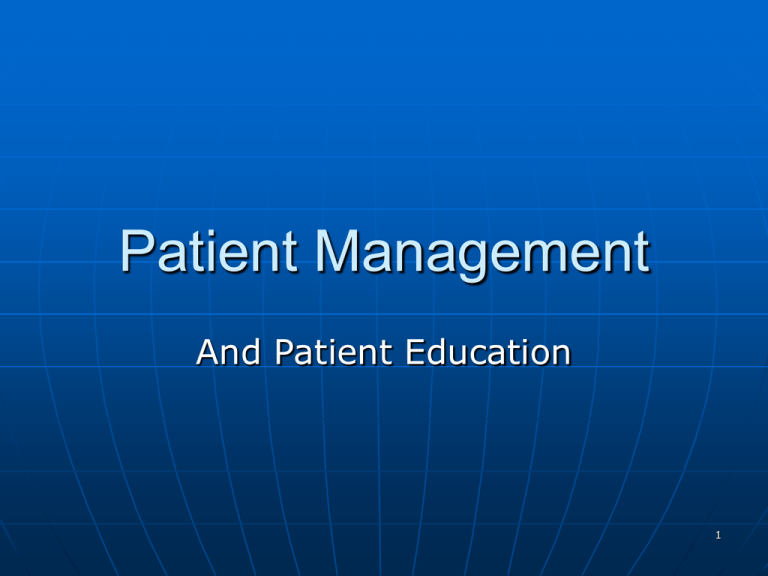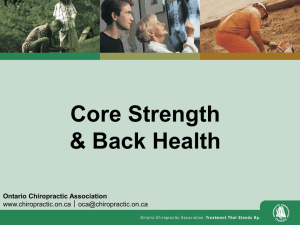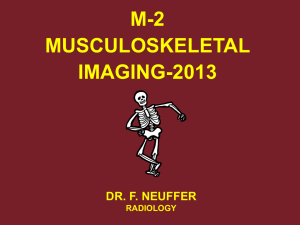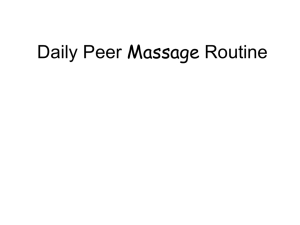Patient Management
advertisement

Patient Management And Patient Education 1 How Dr. Wm. G. Blair Practiced Chiropractors should Locate, Analyze and Correct Vertebral Subluxation To Detect Subluxation… - NeuroCalograph… 2-3 graphs. - Need pattern on sequential visits - Need 1-2 primary Breaks for pattern. - Used a prone leg check (only) 2 How Dr. Wm. G. Blair Practiced List misalignments on x-ray to categorize them. (1o, 2o, 3o) 1o would be the segment putting the most distortion on the cord, found off the APOM through neural canal measurement. Only one segment was adjusted at a time. 3 How Dr. Wm. G. Blair Practiced “Whatever you are going to do, Pattern it”, Dr. Blair on Chiropractic techniques. Once the first adjustment is given you lose the information for that specific subluxation. You can not rely on symptoms. 4 How Dr. Wm. G. Blair Practiced Pattern established with 3 graphs taken on at least 2 separate days no more than 7 days apart. Coined the Tern “Slippage”. - 1 of 2 things will happen 1- Your body will regain control 2- You will subluxate If Dr. Adjusts while patient is in slippage they can cause a bigger problem than the original Subluxation. 5 How Dr. Wm. G. Blair Practiced What happened when he didn’t adjust? 2 concerns: 1. Your Health 2. My reputation 6 How Dr. Wm. G. Blair Practiced Patient Management: Patient checked 2 times per week until they held their adjustment for 6 weeks. Then 1/wk until they held their adjustment for 6 weeks. Then 1x/2wks. Until they held their adjustment for 8 weeks. If they didn’t comply, they weren’t allowed to be seen. (checked 90 patients per day) 7 How Dr. Wm. G. Blair Practiced 1. 2. 3. If patients missed an appointment: They were called to reschedule They were called to reschedule They were written a letter and released from care. “Never let it be economical to miss an appointment” He had sick people to take care of and didn’t have time to mess around. Remember, he was living on borrowed time. 8 How Dr. Wm. G. Blair Practiced If you keep seeing pattern, you are missing something. If legs are short but there is no pattern, the patient is not checkable. 9 Upper Cervical Protocol Blair Technique in the Palmer Clinics In your Clinic 10 Patient Management 1st Visit Consultation, Exam and X-ray 2nd Visit (Finish X-Ray if needed) ROF and 1st adjustment Schedule of Care for visits 3rd-11th visits Visit 12 Documents 11 1st visit 1. 2. 3. 4. 5. 6. 7. Consultation Ask name Acknowledge referral Introduction to chiropractic care 8 parameters Listen to what they say then ask direct questions Look at (touch) symptom area Patient “Yes – Yes” agreement 12 Communicating with a Patient Speak in language they can understand. Most every word you use, they should already know. If they have to think about the meaning of words, they wont hear the meaning of what you are saying. NEVER lie to or mislead your patients. Never try to scare them into care. Be honest about what you do, what you can do to help and what your limitations are. 13 Explanation of Chiropractic Chiropractic is a conservative form of health care. We do not prescribe drugs or perform surgeries. If we feel that is necessary for you, we will refer you to those who specialize in those areas. 14 Explanation of Chiropractic Everything that happens in the body starts with the brain. The brain uses the brain stem, spinal cord and peripheral nerves to link every tissue, organ and cell to the brain. We call this system the nervous system. It is very important to the body. So much so that the body as built a skull to protect the brain, and 24 bones in the spine, plus the tail bone, to surround and protect the spinal cord. 15 Explanation of Chiropractic The problem with this is that every now and then these bones of the spine will become stuck, locked, or just not move as freely as they were designed. When this happens, the communication along the nerves in that area become irritated causing a “short circuit” or “static on the lines”. The communication from the brain to the body becomes compromised. 16 Explanation of Chiropractic In chiropractic we call this “bone out of place and irritation to the nervous system” a Vertebral Subluxation Complex or a “Subluxation”. 17 Explanation of Chiropractic A subluxation may have symptoms around that joint such as pain, muscle spasms and/or swelling. However, you may not have symptoms at all. For example, if the nerves to the heart are compromised, you may not notice the symptoms until you are experiencing high blood pressure.1 18 1. Bakras Explanation of Chiropractic The goal of chiropractic is to take the irritation off these nerves by finding and correcting the bone(s) that are causing the problem. To allow your spine to function the way it is supposed to so your body can function the way it is supposed to. Now, that being said, how can I help you? 19 History The patient explains his/her problem. Doctor gets out of your chair and looks at the area of complaint (if applicable). 8 parameters Explain to the patient what will happen for the rest of the visit (exam and possible x-rays) 20 1st visit Exam Patient Agreement “You need to have a condition we treat. Chiropractors treat subluxation. Which is a misalignment of a spinal bone that causes nerve pressure. Wherever that nerve goes you may have problems with that area.” “We need to find the cause of your symptoms and any secondary problems (what condition you’ve gotten yourself into)” C. “Once we find out what is going on I will be able to tell you if and how I can help” Exam: a. Orthopedic b. Neurologic c. Chiropractic 21 1st Visit 5. Exam (Give pt a brief explanation of what you are looking for) a. Orthopedic b. Neurologic Do as much as you can while the patient is in one position c. Chiropractic - Thermography – Leg Checks - Palpation d. Organic vs. Non-organic 6. Explanation 22 NECK BOURNEMOUTH QUESTIONNAIRE Patient Name ________________________________________________ Date ___________________________ Instructions: The following scales have been designed to find out about your neck pain and how it is affecting you. Please answer ALL the scales, and mark the ONE number on EACH scale that best describes how you feel. 1. Over the past week, on average, how would you rate your neck pain? No pain Worst pain possible __________________________________________________________________________________ 0 1 2 3 4 5 6 7 8 9 10 2.Over the past week, how much has your neck pain interfered with your daily activities (housework, washing, dressing, lifting, reading, driving)? No interference Unable to carry out activity ___________________________________________________________________________________ 0 1 2 3 4 5 6 7 8 9 10 Over the past week, how much has your neck pain interfered with your ability to take part in recreational, social, and family activities? 3. No interference Unable to carry out activity ___________________________________________________________________________________ 0 1 2 3 4 5 6 7 8 9 10 4. Over the past week, how anxious (tense, uptight, irritable, difficulty in concentrating/relaxing) Not at all anxious Extremely anxious ___________________________________________________________________________________ 0 1 2 3 4 5 6 7 8 9 10 5. Over the past week, how depressed (down-in-the-dumps, sad, in low spirits, pessimistic, Not at all depressed Extremely depressed ___________________________________________________________________________________ 0 1 2 3 4 5 6 7 8 9 10 unhappy) have you been feeling? 6. Over the past week, how have you felt your work (both inside and outside the home) has Have made it no worse Have made it much worse ___________________________________________________________________________________ 0 1 2 3 4 5 6 7 8 9 10 7. Over the past week, how much have you been able to control (reduce/help) your neck Completely control it No control whatsoever ___________________________________________________________________________________ 0 1 2 3 4 5 6 7 8 9 10 have you been feeling? affected (or would affect) your neck pain? pain on your own? ________________________________ _________________________________ Patient Signature Examiner OTHER COMMENTS: _________________________________________________________________________________________________________ With Permission from: Bolton JE, Humphreys BK: The Bournemouth Questionnaire: A Short-form Comprehensive Outcome Measure. II. Psychometric 23 Properties in Neck Pain Patients. JMPT 2002; 25 (3): 141-148. http://64.233.167.104/search?q=cache:AAv7g1HZdb4J:www.outcomesassessment.org/Bournemouth%2520Neck.pdf+Bournemouth+ Questionnaire&hl=en&gl=us&ct=clnk&cd=1 (Accessed 9-25-2006) Exam Points of Interest for Evidence Base Practice (It is not recommended that you perform all of these tests on every patient. All exams should be modified to the individual patient) Posture 3 minute step test One leg balance test Hamstring length Thomas test • Psoas • ITB • Quads 24 Organic vs. Non-organic 1. 2. 3. 4. 5. Organic signs (ortho-neuro-chiros) Non-Organic Signs (Waddell signs) Superficial or nonanatomic tenderness —widespread sensitivity to light touch, and pain referred to other areas. Simulation—axial loading (light pressure to the skull should not significantly increase low back pain. Passive rotation of the shoulders and pelvis together in a standing patient should not reproduce low back pain. Distractions—difference of 40 to 45 degrees between the supine and seated straight leg raising tests. Regional disturbances —sensory or motor disturbance ("giving way") that is not neurologically correlated. Overreaction—inappropriate overreaction such as guarding, limping, rubbing the affected area, bracing oneself, grimacing, or sighing are all signs of illness behavior. 25 Evaluation of muscular imbalance Posture – Important for a starting point for spinal stability 3 minute step test – Pre and Post HR • Avg. Men bpm = 101-115, Avg. Women bpm = 112-120 One leg balance test – 30 seconds Hamstring length Grip Strength – 47-49K g Thomas test • Psoas • ITB • Quads Yeomans S. Yeomans Way to physical fitness with permission of the YMCA of the USA, 101 N. Wacker Dr., Chicago, IL 60606 26 Physical Performance Ability Mobility Tests Ankle dorsiflexion mobility/gastrocnemius and soleus length Knee flexion mobility/quadriceps length (Nachlas test) Hip flexion mobility/hamstring length (Straight leg raise test) Hip extension mobility (modified Thomas test/ psoas-rectus femoris length) Hip rotation mobility (internal and external) Lumbar spine mobility Cervical spine mobility 27 Liebenson C. Rehabilitation of the spine, a practitioner’s manual second Edition. Lippincott Williams & Wilkins, Philadelphia, Pennsylvania. 2007 Strength/Endurance 1. Squat Endurance Test a. Repetitive b. Static 2. Trunk Flexor Endurance Test a. Repetitive Sit-up endurance test b. Static quarter sit-up test c. Isometric sit-up test 28 Liebenson C. Rehabilitation of the spine, a practitioner’s manual Second Edition. Lippincott Williams & Wilkins, Philadelphia, Pennsylvania. 2007 Balance/Motor Control One Leg Standing • Eyes Open (30 sec.) • Eyes Closed (21-28 sec.) • Tested with each leg Document your Findings 29 1st Visit Thermography, “Here we have 2 infrared cameras mounted on a wheel. I am going to bring this up the back of your neck. John Hopkins University tells us that the heat coming out of each side of your spine should be off by no more than .3o C. If it is more than .3o C, there is something going on we need to take a closer look at.” 30 Thermography We then look at the differential temperature and the absolute temperature of the right and left sides. Each visit we will take the temperature of your spine. Eventually we will want to see the lines becoming straight. However, it is not uncommon for the scan to have some major deflection due to the change in blood flow after the first few corrections. If an area hasn’t been getting the blood supply it needs, the increase in blood flow after the adjustment will cause us to see a large swing on the graph. 31 Leg Checks, 1st explain posture and the short leg (Clark Poster). Have the patient prone and do all leg checks Prone Leg Checks: “I’m going to be looking at your feet to see what’s happening with your spine. When you are standing we notice the high hip and shoulder. When you are lying down, we notice a short leg; due to the contracted muscles of the pelvis and spine being o of balance. I am going to isolate and stress these muscles along your spine, what we call para-spinal muscles. These tests will help me locate the muscles and nerves involved with your condition so we can find the cause of your problem.” 32 Palpation: palpate the spine. Make sure patient knows when you have found what’s wrong. palpate the chief complaint. Follow the Protocols of Palmer and record your findings. Document your findings. When you locate t&t fibers don’t be afraid to ask your patient about them. This will confirm that you have found something. 33 st 1 visit Explanation: “What we have found is you do have a spinal subluxation in your neck that is causing a reflex in your spine and pulling it out of balance. When we isolate these nerves & muscles, your spine and legs are unbalanced. When I take these nerves & muscles out of the equation, your spine balances and your legs become level.” “So now we know where the problem is. What we need to know is how to fix it. That’s what the x-rays are for.” “We take the most diagnostic set of x-rays, Chiropractically or Medically, for an articular misalignment of the spine. When we are finished we will know exactly what’s going on with every one of the 17 joints in your neck”. 34 1st visit X-rays Base Posterior First APOM, AP and Lateral Stereo Laterals Protractos 35 1st Visit Dismiss for 1st day Tell them what to expect for the second day. “It will take me approximately 1 hour to go over with you everything we have found today and give you your adjustment.” -Give icing instructions if needed 36 Blair Upper Cervical Spinographic Analysis Sheet 37 2nd Visit 1. 2. 3. 4. ROF –High points of ROF Welcome Back What is a Subluxation (KISS) What we found (Good & Bad) How we are going to help (stages of care and frequency) 5. 6. 7. Program of care Patient’s Responsibility Informed Consent (Follow instructions) 38 Explanation of X-Rays Explain the x-rays by starting with the APOM and Lateral in the view box. Explain the findings of the x-rays in plain terms the patient can understand. 39 Explanation of X-Rays If you want to show them your protracto views, bring them out, explain that “these are the pictures we take to give us the exact position of the first neck bone”. You can show them the Atlas and Condyles But do not go further. They will be confused and loose focus. I them I “used to explain more but found patients just got a headache, however, if 40 they want” me to explain more I will. 2nd Visit Adjustment – explain what will happen and show the drop headpiece Rest – Take them back and have them rest (Dr. should do this the first time) Re-check after first adjustment Have patient schedule for 1st stage of their care 41 Explaining the Adjustment You are going to lie on your side with your head resting on this headpiece. I am going the lift up on the headpiece (cock the headpiece), tap on your neck like this (with your finger, tap on the patients arm mimicking the adjustment) and the table will drop (push down on the headpiece, it will make a noise when it drops). You will hear that noise, and it will be load because your ear is right there. 42 Explaining the adjustment Most people don’t feel much during the adjustment. You may not feel much more than the headpiece drop. What we want is the type of physics that by being light and quick with the adjustment, it would be like pulling a cloth out from under a vase of flowers. We can get the bone to move without having you feel much of the correction at all. After the adjustment I would like you to hold still for a few moments. I will tell you how to get up off the table when it is time. 43 Program of Care Initial Frequency: 3 times per week for 2 weeks, followed by 2 times per week for 4 weeks, followed by 1 time per week for 6 weeks. Re-Exam in 6 weeks includes a Neutral Lateral Spinograph Goals: Should include Functional ADL 1st 2 weeks is pain relief, next 10-20 are corrective and strengthening care, further care is typically supportive… however, every case is an individual and a longer corrective and strengthening phase may be necessary. 44 Care Management: Daily Check List Daily Office Visit Graph Prone Leg checks Document Review Symptoms Review Pt. Mgmt. Protocols Course for care Teach time Adjust 6 Points Pt tells what’s wrong Dr. Show what’s wrong Fix what’s wrong Pt acknowledges fix Make smile (One liner) Give hope (but don’t lie) 45 Patient Management Protocol: Reduce Subluxation (Adjust when indicated) Allow Healing to Take Place (Lesions heal, scar tissue to form) Stop Inflammation (Cont. Adjusting, Ice, Biofreeze) Passive ROM Stretching (Dr. Motions Joints) Restore Posture Active ROM Stretching/Exercises (Chin Glide, ROM stretching) Restore Strength in Muscles/Ligaments Restore Balance and Coordination Restore Aerobic Conditioning Restoration of Spinal Biomechanics (Re x-ray – C-spine, Flex/Ext) Active Daily Living Rehabilitation (For Pt. Specifically) Start Back into Sport/Job/ADL Return to Normal Function (Objective testing to indicate end of repair treatment) Exercises Given: (Both Patient and File need a copy) 46 Care Management: CHIROPRACTIC EDUCATION Subluxation Tytron Thermographic scan Leg Checks Safety Pin Cycle Educate Patient of Injury (ROF, Class, Video, Brochure) Stop Patient From Hurting Themselves PRACTICE MANAGEMENT Thank Referral Share the Secret Dz of the week Get excited about pt results Red Cross Certified Back Care Instructor (Instructions for Lifting, ext.) Educate Patient on How to limit Regression (Follow up Health Care Instructions) 47 Care Management: Upper Cervical Care in the 21 Century What is it about? 1. Detecting and Correcting Subluxations 2. Focus on Keeping the Spinal Correction as long as possible 3. Evidenced Based Practice/Care 48 Detecting and Correcting Subluxations Tytron Thermographic Pattern Analysis (Subluxation Present) Specific Blair Spinographic Radiographs (Misalignment) Leg length Indicators (Segment involved) Monitor the Patient’s progression through the cycles of healing 49 Evidenced Based Practice/Care Use Questionnaires (Oswestry, Bournemouth) to follow progression of patient. Perform examinations that can actually help you with the evaluation of the chiropractic patient. • Steve Yeoman’s Text “The Clinical Applications of Outcomes Assessment (www.yeomansdc.com) 50 Using Functional Performance Tests Safety – Protecting patients from injury Reliability – Test scores are dependable across the evaluation Responsiveness – Tests should uncover meaningful deficits in patient’s condition Validity – Test scores can predict the response to care by the patient Practicality – Tests are easy to administer and exercises are easily preformed. 51 Focus on Keeping the Spinal Correction as long as possible Teach patient proper posture Teach patient how to lift, sit, work… Use exercises that are focused on improving patient’s functional deficits Exercise (just do something) Bracing, Taping 52 Teach patient proper posture 53 Teach patient proper posture Have patient do the cat and camel exercise 54 Bracing, Taping 55 If you are to Adjust to the Lower Spine (The Blair technique does not recommend adjusting the lower spine. However, each DC must make the decision of how they will practice chiropractic with their patients. This is my recommendation if you feel you must adjust the lower spine. Give it at least 2 weeks before you do anything (longer if the patient lets you) allow for the body to correct itself. Monitor the spine to confirm a consistent and persistent problem. Indicators must show up for more than 2 visits in a row. Use the Tytron C3000, Dual Probe or stress/pressure checks to confirm neurologic interference. I have found that I have lost control of my patient care more often when I have adjusted the lower spine before the body was ready to correct it. I tried to give the patient a little pain relief and end up causing a bigger problem. Once you have given the lower spinal adjustment, monitor the patient closely to control the reaction to the new adjustment. Do not get in the habit of multiple manipulations up and down the spine on every visit. 56 Putting it all together: Visits 3-12 Biggest complaint from doctors who turn a full spine or mixing practice into an upper cervical practice is that they do not see their patient’s enough or see enough patients to make it work. Here is a simple example of how it works: A complete history and Initial Examination 1. Adjust the patient when needed and leave them alone when needed 2. Help the patient help themselves by leading them through the development of a healthier lifestyle. a. Functional improving exercises b. Referrals when needed c. Re-evaluate your patient on a timely basis and MANAGE their care. Something to think about: CPT Code: 98940 98941 RVU: .69 .96 97110 97530 .74 .77 57 Converting Blair Listings to Palmer Listings: C1: ASR ASL PIR PIL = = = = ASR ASL AIR AIL Lower PRI = PLI = ARS = ALS = Cervicals: PR PL Sp-R, ESR Sp-L, ESL To be used if you are being observed by a doctor not comfortable with The Blair technique or if it is a medicare patient where a staff doctor has To adjust the patient. 58 59








